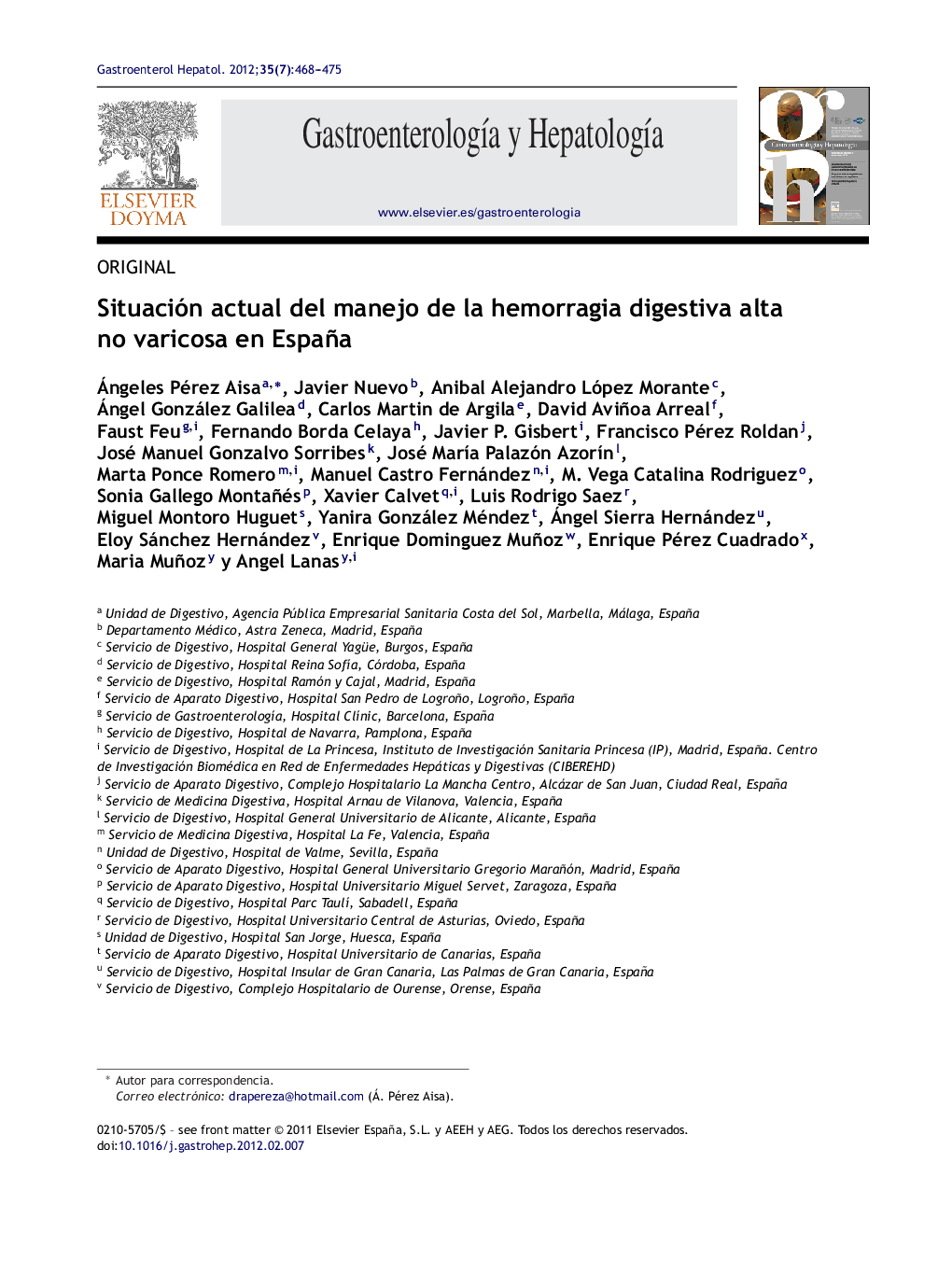| کد مقاله | کد نشریه | سال انتشار | مقاله انگلیسی | نسخه تمام متن |
|---|---|---|---|---|
| 3288234 | 1209496 | 2012 | 8 صفحه PDF | دانلود رایگان |

ResumenIntroducciónLa mortalidad en la hemorragia digestiva alta no varicosa (HDA-NV) no ha variado. Se necesita conocer más información para mejorar las estrategias de tratamiento. Los objetivos de este estudio fueron: a) describir el perfil de presentación de los episodios de HDA-NV; b) el manejo clínico según práctica clínica habitual, y c) establecer cuáles son los resultados clínicos asociados a los tratamientos endoscópicos y médicos en España.MétodosENERGIB fue un estudio retrospectivo de cohortes que recogió información del manejo y forma de presentación de HDA-NV en Europa. Presentamos los datos relativos a España. Los pacientes se trataron según la práctica clínica habitual. Para las variables cuantitativas se calculó la media y la desviación estándar y para las categóricas se calcularon frecuencias absolutas y relativas.ResultadosLos pacientes (n = 403) fueron hombres (71%), con edad media 65 años, asociaron comorbilidad (62,5%). Los equipos encargados de su manejo fueron gastroenterólogos (57,1%) o médicos internistas (25,1%). Los inhibidores de la bomba de protones se usaron de forma empírica preendoscopia en un 80% de los casos. El 6,4% presentó persistencia y el 6,7% resangrado después de la endoscopia. La tasa de mortalidad en los 30 días posteriores fue del 3,5%.ConclusionesEste estudio permite conocer el perfil de presentación de los episodios de HDA-NV en España y el manejo en práctica clínica habitual. Este se ajusta a los estándares propuestos por las recientes guías de práctica clínica. Entre otros datos destaca que los pacientes con hemorragia son cada vez de edad más avanzada y presentan un mayor número de enfermedades asociadas, lo que podría explicar que la mortalidad se haya mantenido estable a pesar de los evidentes avances en el manejo de esta entidad.
BackgroundMortality related to nonvariceal upper gastrointestinal bleeding (NVUGIB) has not changed. More information is needed to improve the management of this entity. The aims of this study were: a) to determine the characteristics of bleeding episodes, b) to describe the clinical approaches routinely used in NVUGIB, and c) to identify adverse outcomes related to endoscopic or medical treatments in Spain.MethodsThe European survey of nonvariceal upper GI bleeding (ENERGiB) was an observational, retrospective cohort study on NVUGIB with endoscopic evaluation carried out across Europe. The present study focused on Spanish patients in the ENERGiB study. The patients were managed according to routine care. The mean and standard deviation were calculated for quantitative variables and absolute and relative frequencies were calculated for categorical variables.ResultsPatients (n=403) were mostly men (71%), with a mean age of 65 years, and co-morbidities (62.5%). Most of the patients were managed by gastroenterologists (57.1%) or internal medicine teams (25.1%). A proton pump inhibitor was used empirically in 80% before endoscopy. Bleeding persistence occurred in 6.4% and recurrence in 6.7%. The mortality rate at 30 days was 3.5%.ConclusionsThis study contributes to the characterization of Spanish patients and NVUGIB episodes in a real clinical setting and identifies the routine management of this entity, which is in line with the standards proposed by recent clinical practice guidelines. A notable finding was that age and the number of comorbidities in NVUGIB patients were increasing. These factors could explain the persistent mortality rate, despite the evident advances in the management of this entity.
Journal: Gastroenterología y Hepatología - Volume 35, Issue 7, August–September 2012, Pages 468–475